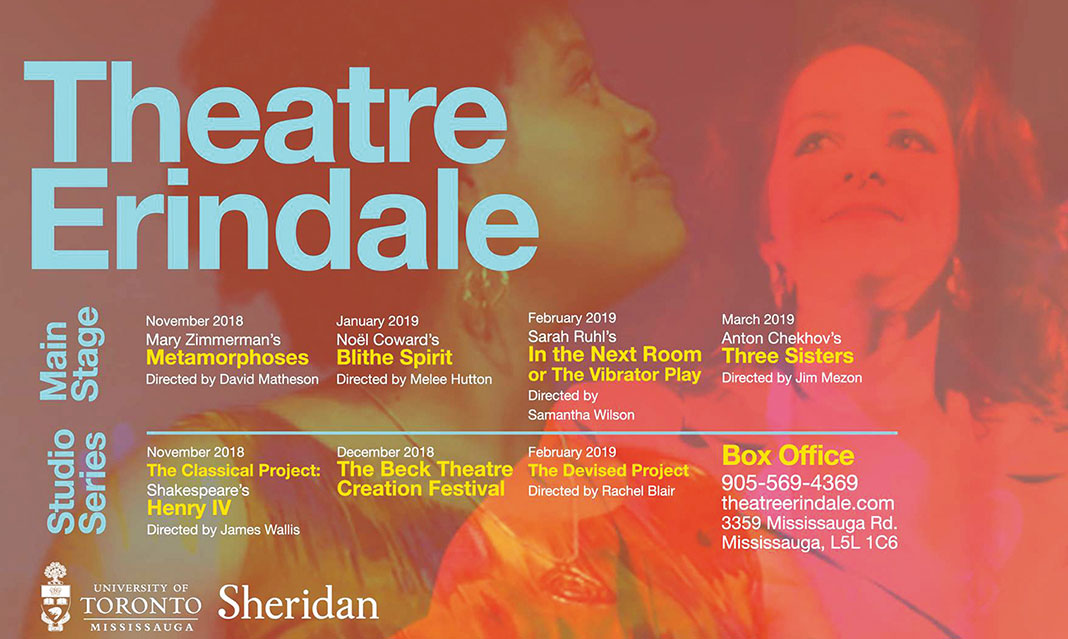Theatre Erindale kicked off their studio series with Henry IV, Part 1 and Part 2. Directed by James Wallis, the show launches the third-year Theatre and Drama studies class into their first Theatre Erindale season. This show is a prime example of a director relying on the text to tell the story, and for that reason, the drive for the show falls almost entirely on the backs of the actors.
The direction for Henry is neutral to the point of near non-existence. With no bold interpretation of the text, this show puts a spotlight on the acting, since the actors are essentially the only thing there is to pay attention to. There was no established time period, which was reflected in the mish mash of traditional Shakespearian garb and modern apparel. Props and set pieces were used in the most literal way possible and lighting and sound cues were kept to a bare minimum. This show is not a reinterpretation of Shakespeare’s work, nor does it play with the story or highlight specific themes. It seeks, instead, to tell the story as written.
Henry IV, Part 1 and Part 2 are the second and third plays in Shakespeare’s tetralogy dealing with the successive reigns of King Richard II, Henry IV, and Henry V. Part 1 introduces Henry IV during his unquiet reign of England. His son, Hal, the future King Henry V, is spending all of his time getting drunk in taverns with his low life friend John Falstaff, putting a strain on the relationship between father and son. At the same time, the King is at odds with the Percy family, who are plotting a rebellion against him for failing to acknowledge his debt to them for helping him acquire his thrown.
In Part 2, the rebellion has been defeated but the King is growing ill and Hal, knowing he will have to assume the throne after his father’s death, distances himself from his old friend Falstaff. Part 2 also follows Falstaff, now an army captain, as he travels around the country side recruiting young men to serve in an upcoming battle.
In Part 1, the text is placed at the forefront. The text drives the narrative, often at the expense of creating clarity in the story telling. The main strength of this part of the shows was derived from its monologues. Every actor delivered a confident performance of the Shakespearian text, most notably Falstaff, played by Samantha Dodds and King Henry IV, played by Emma Ratcliffe, yet many of these moments stood in isolation from the rest of the show. Interpersonal relationships were often left unestablished, which in turn made the relationship driven aspects of the plot murky.
This, however, was quickly remedied in Part 2, much to the credit of Max Ackerman in the role of Falstaff. Although Ackerman played a messy alcoholic, there was never a sense that he didn’t have full control of the stage. He gave a generous performance, establishing a clear relationship with every character he interacted with, and if the stage was bare, he would turn his connective energy towards the audience, using soliloquies as opportunities to play off the audience. His performance showed, not only a clear grasp of the language, but also a full awareness of the larger story at work.
Scenes between actors Daniel Gravel and Ackerman brought necessary chemistry and levity to the show. As Justice Shallow, Daniel Gravelle gave a nuanced performance, bringing magnetism and zing to an easily dismissible role. His shifts between conservativism and humour were tied together nicely by the gentle lilt in his voice, which imparted warmth onto his entire performance.
The relationship between Hal and King Henry finally came together in their last scene. In their final confrontation, the King, played by Michael Roy Course, is seen, bitterly clinging to life. After initially accusing his son, played by Sarah Abdel Rahman, of not truly loving him, the two engage in an emotionally charged exchange, ending in a tearful reconciliation between father and son. Both actors deliver a poignant performance, bringing weight to the final moments of the strained relationship, which ultimately brings both shows together.
Henry IV, Part 1 and 2 are lengthy plays, sandwiched in the middle of a long and complicated historical tetralogy. Mounting these stories was no small feat for a debut performance. James Wallis‘ cast rose to the occasion, delivering extremely technical performances that span over four hours collectively.
If you already appreciate Shakespearian drama and the poetry of the language or have an interest in supporting student actors and are willing to learn alongside them, this is a show for you.
Henry IV, Part 1 and 2 runs at Deerfield Hall Studio Theatre from November 8 – 18.



